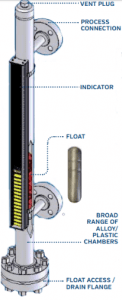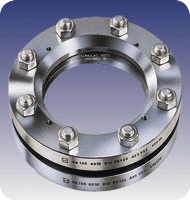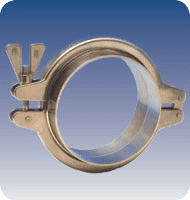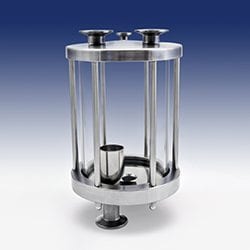A View on Quality—Observation Ports and Considerations for Food and Beverage Applications
Posted on July 12, 2023 by John GiordanoColor, clarity and consistency. These are just three characteristics that operators can monitor with a sight glass observation port when processing food or beverage products. A sight glass window can supply a visual means to ensure proper blending or mixing, accurate measurements and adherence to stringent quality standards. The equipment includes more than just the glass itself. Proper selection of the components for the observation port includes temperature, pressure, chemical compatibility and hygienic standards, among others.
Any components selected for the system should be properly rated to ensure that any pressure spikes and/or temperature variations can fit within the equipment specifications. Particularly within food processing, due to the clean in place (CIP) or clean out of place (COP) procedures, the combination of the pressure, temperature and caustic solutions will dictate the observation port material selection and safety features.
Wide temperature swings, for example, running a process at 250°F and switching to 70°F cleaning fluids immediately following, can greatly impact material choice for the glass itself. Proper material selection can help prevent system failure and provide a more durable, long-lasting solution.
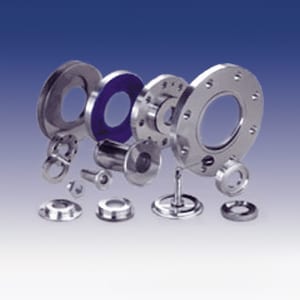
Breaking down the components of a sight glass observation window
Glass selection is an important consideration for food processing observation ports. Various types are available such as borosilicate glass, quartz glass or METAGLAS® from LJ Star. Borosilicate offers excellent thermal shock resistance to aid with applications involving temperature fluctuations. Quartz glass, on the other hand, offers exceptional high-temperature resistance and superior transparency, making it ideal for processes requiring elevated temperatures or where ultraviolet UV transmission is necessary.
METAGLAS® is considered the safest sight glass available, meeting the DIN7079 standard and was created to improve safety conditions within plants that handle processes involving corrosive chemicals, high temperatures and high-pressure situations. This standard for fused-glass sight glasses sets a high mark for strength, chemical resistance, thermal properties, etc.
In making METAGLAS, glass is melted inside a circular metal frame to fuse the glass and metal. The cooling process creates a uniform compressive stress throughout the glass, making it the most secure and strong glass for sight window applications. Metaglas is rated for temperatures as high as 536°F or in overpressure situations.
This borosilicate glass resists chemical degradation or disintegration, especially compared to soda lime glass, which can degrade under slightly acidic conditions (pH=6) or alkaline conditions (pH=10). Food and beverage products fit within the pH spectrum as either acidic or alkaline with a broad spectrum of products pH 6 or lower, such as certain dairy products, juices, meat products, or alcoholic beverages such as beer or wine.
Equipment components to consider for observation ports
In addition to the glass itself, the observation port consists of the following components:
- Frame or housing: This supplies robust structural support and encloses the sight glass assembly. It is usually made of stainless steel or another durable material that provides chemical compatibility for the materials within the tank, vessel or pipeline.
- Gasket or O-ring: This helps create a tight, hermetic seal between the sight glass and the surrounding frame or housing to help prevent leaks.
- Clamps: These secure the observation port within the frame or housing. This supplies the necessary pressure to maintain a secure and leak-free connection.
- Lighting source: Sometimes, an observation port may incorporate a lighting source to enhance visibility inside the vessel or pipeline. Explosion-proof lighting is available for volatile situations.
- Cameras: A camera fitted to the observation port supplies a live video feed or can capture still images of the process or product. This allows remote monitoring and documentation of the process without direct visual access. It is beneficial when the process tank is difficult to access when multiple processes or tanks must be observed simultaneously, or if a process involves volatile or caustic substances that could compromise worker safety.
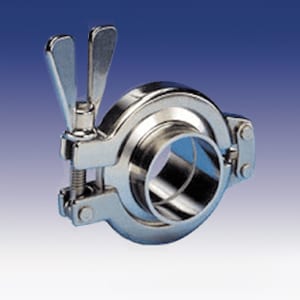
Don’t overlook clamps rated for high-pressure applications
A sanitary clamp is critical in a sight glass observation port by providing a secure, leak-proof connection. The sanitary clamp ensures a tight and hygienic seal between the sight glass and surrounding equipment. For food operations, in particular, it helps meet stringent FDA regulations for sanitary and secure equipment. The seal prevents any potential leaks, contamination, or introduction of foreign materials to maintain both system and product integrity.
Clamps are available with different ratings, such as the Series SSHJ hygienic clamp from LJ Star for high-pressure applications. Size ranges are more limited for high-pressure clamps, with the Series SSH ranging from one-half inch up to six inches in size, while other sanitary clamps are available up to twelve inches. However, the pressure rating of up to 1450 psig (pounds per square inch gauge) is more than double that of ordinary clamps.
In addition, there are safety clamps that require an extra step to disengage. Pressure swings, for example, or a steam line might cause connections to loosen, and a standard clamp could disengage. A safety clamp might loosen, and the fitting could leak, but the safety feature can help prevent a catastrophic blowout and minimize the extent of necessary repairs.
Another available feature is a safety lockout. This helps limit access and restricts activity on that vessel or pipe to authorized or trained employees. The lockout clamp, for example, can restrict access to a high-pressure system for qualified staff to undo once the system is completely depressurized.
In some cases, such as seed oil extraction, these safety mechanisms protect against the action of volatiles involved in their processing, such as hexane. Observation ports frequently are utilized in seed oil extraction vessels or pipelines for products from canola oil to cannabis or soybeans to sunflowers. There will always be connection points in any processing system, whether points of transfer to the next processing stage, pipelines or observation. These connections can pose a weak point without safety features that can help protect against system failure and human error.
Overall, any high-pressure application requires more frequent inspection and maintenance routines. Establish a schedule for regular inspection of the sight glass port. Focus on checking for leaks, cracks or signs of stress.
Selecting the materials and components that will meet project specifications for high temperature, high pressure and other environmental stressors boils down to working with a trusted supplier that practices quality manufacturing and meets or exceeds safety standards.
LJ Star has a proven track record supplying sight glass observation windows and equipment for thousands of applications across industries, including food and beverage processing. Our production facilities are located onshore, as well as our customer service department, to help you meet your goals for productivity, safety and cost control. Contact us today to learn more about our extensive line of process observation equipment.
Subscribe to our Blog
Categories
- Certifications
- Company
- In The News
- Industry Information
- METAGLAS® Sight Glasses
- PackExpo 2020
- Sanitary Clamps
- Sanitary Fittings
- Sight Flow Indicator Benefits
- Sight Glass Applications
- Sight Glass Construction
- Sight Glass Lighting
- Sight Glass Lights
- Sight Glass Process Vessel Camera
- Sight Glasses
- Trade Shows
- Webcast
